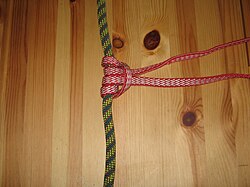(Marked this version for translation) |
m (W126jep moved page Adventist Youth Honors Answer Book/Knot/Prusik to AY Honors/Knot/Prusik without leaving a redirect: Part of translatable page "Adventist Youth Honors Answer Book/Knot/Prusik") |
||
| (5 intermediate revisions by the same user not shown) | |||
| Line 1: | Line 1: | ||
| − | <noinclude><translate><!--T: | + | <noinclude><translate><!--T:5--> |
</noinclude> | </noinclude> | ||
{{Knot | {{Knot | ||
| name=Prusik knot | | name=Prusik knot | ||
| image= Prusikhowto4.jpeg | | image= Prusikhowto4.jpeg | ||
| − | | use = A '''Prusik (aka Prussik or Prussic)''' is a friction hitch used in climbing, canyoneering, caving, rope rescue and by arborists to grab a rope (sometimes referred to as a ''rope-grab''). | + | | use = A '''Prusik (aka Prussik or Prussic)''' is a friction hitch used in climbing, canyoneering, caving, rope rescue and by arborists to grab a rope (sometimes referred to as a ''rope-grab''). The term '''Prusik''' is used both for the knot, for the loops of cord, and for the action ('''to prusik'''). |
| − | + | A Prusik rope is a circular loop with a circumference of {{units|20 to 100 cm|8-40 inches}} depending on its intended use. Two Prusik ropes are tied to another rope which is anchored above. When the Prusik knot is under tension, it grabs the rope to which it is tied. When not under tension, it is easily moved. The climber places one foot into each loop, and shifts all of his or her weight to one of them, releasing the tension on the other. The rope without tension is then slid upwards on the vertical rope. The climber then shifts his or her weight to the other loop and slides the first one up. This is repeated until the rope has been ascended. | |
| − | + | Prusiks will work around two ropes, even two ropes of different diameters. Prusiks provide a high-strength and relatively fail-safe (i.e., they will slip before damaging the rope or breaking) attachment, and are used in some rope-rescue techniques. Prusiks are good to use in hauling systems where multiple rope-grabs may be needed, and where mechanical rope-grabs are not available. | |
| − | A Prusik rope is a circular loop with a circumference of {{units|20 to 100 cm|8-40 inches}} depending on its intended use. | ||
| − | |||
| − | |||
| − | Prusiks will work around two ropes, even two ropes of different diameters. | ||
| − | |||
| − | |||
Although the Prusik Climb technique may be called old-school by some, the US Army still includes it in its annual Best Ranger competition. Rangers in the competition routinely make it up a 90 foot rope in under a minute. | Although the Prusik Climb technique may be called old-school by some, the US Army still includes it in its annual Best Ranger competition. Rangers in the competition routinely make it up a 90 foot rope in under a minute. | ||
| tying_instructions = | | tying_instructions = | ||
| − | The Prusik is tied by wrapping the prusik loop around the rope a number of times (depending on the materials, but usually 3-5 times), and then back through itself, forming a barrel around the rope, with a tail hanging out the middle. | + | The Prusik is tied by wrapping the prusik loop around the rope a number of times (depending on the materials, but usually 3-5 times), and then back through itself, forming a barrel around the rope, with a tail hanging out the middle. When the tail is weighted the turns tighten around the main rope and grab. When weight is removed the loop can be slid along the rope by placing a hand directly on the barrel and pushing. The trick is, if it grabs well, then it is hard to slide along the rope. '''Breaking''' the Prusik free from the rope after it has been weighted can be difficult, and is easiest done by pushing the ''bow'', being the loop of cord which runs from the top wrap, over the knot to the bottom wrap, along the tail a little. This loosens the grip of the hitch and makes movement easier. |
<gallery> | <gallery> | ||
Image:Prusikhowto1.saa.jpeg|Step 1 | Image:Prusikhowto1.saa.jpeg|Step 1 | ||
Latest revision as of 13:43, 8 September 2021







